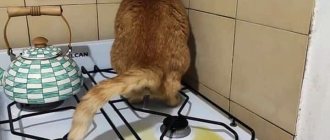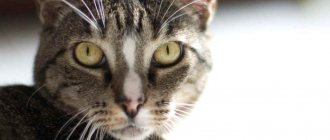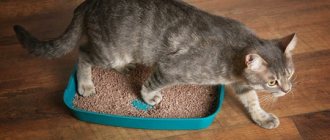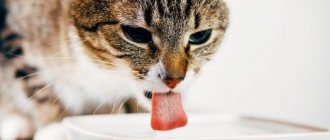Vomiting in cats is not always a sign of illness. Many animals specifically cause it when they feel heaviness in their body. However, if you can identify blood, bile or mucus in the vomit, then you should be wary.
But the owner will not always be able to distinguish whether the cat has a disease or whether it was a physiological need.
If vomiting is accompanied by additional symptoms - diarrhea, fever, then you should definitely show the animal to a veterinarian.
Vomiting is observed in cats with most infectious diseases, poisoning, and diseases of the gastrointestinal tract. Some of the most serious causes of vomiting in cats are intestinal obstruction and volvulus. In this case, only emergency assistance from a veterinarian can save your pet’s life.
Types of vomiting in cats and kittens:
A cat vomits blood - the most dangerous vomit!
Cat vomits white foam
Cat vomits yellow liquid
Causes of vomiting in cats:
The reasons may vary, but they are all indicators that your pet has health problems and will need help.
Sometimes, of course, cats themselves provoke vomiting in order to free the esophagus or stomach from a foreign object that has entered it, for example, trichobezoar is a common phenomenon (an accumulation of hair in the animal’s stomach and the formation of a coma from it).
If the cat is not bothered by the trichobezoar, then vomiting can be caused by:
- viral infections;
- diseases of the gastrointestinal tract;
- banal poisoning;
- the presence of worms and other parasites;
- tumors;
- bacterial diseases.
In general, vomiting is a common accompanying symptom of almost all diseases. Even under normal stress, a cat can vomit.
Usually, vomiting is accompanied by a couple of other signs of a particular disease, for example, lethargy, apathy, diarrhea, poor appetite, and increased body temperature. The only thing that should be well remembered when vomiting occurs is that you should never try to cure the animal yourself; in such situations only a doctor can help.
Causes
Wool balls
Cats are naturally very clean animals and spend most of the day grooming themselves. When your cat grooms itself, tiny hook-like structures on their tongue trap loose and dead hair, which is then swallowed. Most hair passes through the digestive tract without problems, but sometimes hair remains in the stomach and forms a hairball.
© shutterstock
Cats usually vomit clear liquid in front of a hairball. While the occasional cat vomiting water with a hairball may be normal and not cause for concern, it is important to note that hairballs should not be frequent, painful, or difficult for your cat to deal with. To prevent hairballs in your cat, there are over-the-counter dietary supplements available in chewable or gel forms. Regular brushing and making sure your cat is comfortable with the brushing can also help get rid of loose hair on your cat's coat that she might otherwise ingest while grooming herself.
Food and dietary changes
When your cat's feeding schedule changes, if she skips meals or eats later than usual, she may vomit water.
Additionally, you may have changed your cat's food too quickly. When introducing a cat to a new diet, it is recommended to do so gradually over five to seven days, gradually reducing the amount of cat food used and increasing the amount of the new food.
Your cat may eat too quickly and this may cause clear or clear vomiting of food. If your cat has intestinal sensitivity, this may be the cause of vomiting partially digested or undigested food. If your veterinarian has ruled out other medical problems and believes that what your cat is vomiting water is actually food, he or she may ask you to try a commercial sensitive food with your cat. If your cat is still struggling with vomiting on this special diet, she may want to put her on a strict hydrolyzed protein diet.
Your veterinarian may also offer your cat food puzzles. Food puzzles are a great way to play and enrich your cat. There are more and more pre-made food puzzles on the market that stimulate both your cat's predatory and feeding instincts. An added benefit of food puzzles for a cat that constantly vomits food is that it slows down the timing of eating so that the cat can't eat too quickly and then gets sick from it.
Indigestion
Just like humans, a cat's stomach produces various gastric juices as well as hydrochloric acid to help digest food. However, if the cat skips a meal for some reason or is not fed on time, the buildup of juice and acid can irritate the stomach and cause vomiting. Cats with an upset stomach may vomit water, yellow foam, and white foam. If you and your veterinarian suspect that your cat is vomiting due to indigestion, your veterinarian may advise feeding her small, frequent meals at the same times throughout the day to reduce the buildup of stomach acid.
© shutterstock
Gastritis
If your cat likes to do things she shouldn't, she may have irritated her stomach with something she ate. When this happens, you may see vomiting water in addition to vomiting blood and/or bile.
Your cat may also have a decreased appetite, depression, lethargy, or dehydration. Your veterinarian will know what to do if your cat is vomiting due to gastritis.
Some other reasons
- Parasites
- Constipation
- Obstruction of the intestinal tract by foreign material
- Ingestion of toxin
- Metabolic disorders such as diabetes, kidney disease and hyperthyroidism
Cat vomits after eating
When a cat is provoked to vomit after eating, this may indicate problems with the stomach, intestines, and also a very dangerous disease - intestinal obstruction. If the cat vomits once, there is no need to worry; it may be a single reaction of the body to any irritant.
If a cat experiences vomiting more than once, then you should seek professional help from our clinic, since the sooner a cat’s disease is diagnosed, the greater the chance of curing it and saving its life (for example, in the case of intestinal obstruction, days and hours count ).
Treatment of vomiting in a cat
Our specialists begin treatment of vomiting in a cat by collecting anamnesis and additional research. Depending on the existing picture, the doctor prescribes blood and urine tests. If you suspect a particular disease, an X-ray examination, ultrasound, special tests, samples, and so on will be necessary.
Before your cat is taken to the hospital, you will need to relieve her condition. To do this, stop feeding and watering the animal.
Never try to induce vomiting in a cat yourself unless you are sure that it has not eaten any chemicals or liquids, because then the animal will only get worse, because poisons leaving the stomach through the esophagus have a destructive effect on the organs. Therefore, the only thing you can do is to make sure that the cat does not eat anything else until it is examined by a doctor.
Diagnosis of diseases
If your cat is vomiting, you should immediately contact a veterinarian. Only in a clinical setting, based on laboratory and instrumental studies, can the exact cause of the development of a dangerous symptom be established.
A qualified physician must perform a thorough clinical examination of the sick animal using palpation and auscultation (listening and tapping) methods. It is also important to collect a detailed history - the duration of vomiting, frequency, nature of the erupted masses, and the animal’s diet.
A clinical examination includes recording body temperature, pulse and respiratory rate. The condition of the visible mucous membranes and the condition of the cat's sublingual space are also noted. When performing palpation, the doctor can determine the presence of stagnant food masses in the intestines, the thickness of thin sections, the boundaries of the liver and the presence of effusions into the abdominal cavity.
Laboratory diagnostic methods include:
- general blood analysis;
- blood chemistry;
- serological studies using PCR and ELISA to identify dangerous pathogens (panleukopenia and parvovirus enteritis);
- general urine analysis.
To make an accurate diagnosis, the laboratory data obtained is not enough, therefore, in parallel, the cat undergoes an ultrasound examination of the abdominal organs (carefully examining the thickness of the walls of the intestines and stomach, as well as the liver and pancreas), an endoscopic examination, which includes the collection of biomaterial from the mucous membranes of the digestive tract for further research.
It is not uncommon for respiratory problems and bloody vomiting to occur, or respiratory diseases are suspected, and an X-ray examination is prescribed. This allows you to most accurately assess the general condition of the pet.
Diarrhea and vomiting in cats
A single vomiting in a cat with fur is quite common, but diarrhea and vomiting in cats is already a reason to contact a veterinarian .
- Try to remember when the cat first vomited, how often it occurs, what its consistency is, and whether there are any other symptoms.
- Pay special attention to the color of the vomit: yellow and especially green, it signals that the cat has serious problems with the gastrointestinal tract.
Also, vomiting with mucus indicates chronic gastritis and even worms. Especially if mucus is also present in the stool.
Symptoms
Foaming at the mouth of a cat is a cause for concern for the animal owner. The cause may be either a normal physiological condition (with regurgitation of hairballs) or the development of serious dangerous diseases (rabies). Especially if the saliva foams at the mouth. In such cases, it is recommended to immediately isolate the cat and take it to a veterinary clinic.
The appearance of foam in a cat’s mouth when vomiting, which occurs as a result of prolonged fasting, intoxication, and stressful experiences, as a rule, is not distinguished by other characteristic signs other than nausea. The erupted gastric contents have no foreign odors or impurities.
If there are foreign impurities in the vomit, an unusual yellow or green color, as well as a foul odor, you must contact a veterinary hospital and show your pet to a doctor. The appearance of the following characteristic symptoms requires immediate intervention from a specialist:
- the cat vomits too often, vomiting almost never stops;
- body temperature increases or, on the contrary, decreases;
- there is a cough, discharge from the eye and nasal cavity;
- appetite is impaired;
- the general condition of the animal is depressed;
- profuse diarrhea appears.
When a cat vomits pink liquid with foam, you cannot hesitate. The cause of such vomiting may be a stomach ulcer or a perforation of the esophagus. Pink color indicates blood impurities and indicates damage to the mucous membrane of one part of the digestive tract.
The color and presence of particles in the vomit can characterize the degree of neglect of the pathological condition:
- vomit with white foam is most often a sign of prolonged starvation of a pet;
- the presence of mucous white inclusions in the liquid ejected by the stomach indicates that the cat is infected with helminths;
- if a cat is vomiting yellow foam, the cause may be a dangerous illness - carnivore plague or panleukopenia;
- the gray color of the vomit indicates a violation of the diet and the presence of remains of granulated food;
- dark green, almost black color of vomit may be evidence of oncology in the digestive tract;
- yellow vomiting occurs when there is a violation of the functional characteristics of the gallbladder and liver structures;
- vomiting in a green fountain – intestinal obstruction;
- vomiting with feces is a sign of injury to the lower intestines.
Severe, ongoing nausea and vomiting lead to rapid dehydration and disruption of water and electrolyte balance. Visible mucous membranes turn pale, become dry, and saliva is viscous. The animal is depressed, and in advanced cases, seizures or convulsions are noted. It is important to contact a specialist in a timely manner, since any delay can result in the death of the cat.
What to do when a cat vomits
What to do if your cat is vomiting depends on the nature of its manifestation. If a cat is tearing its hair, then it is worth monitoring it more carefully and combing it more often. If you are vomiting with bile and mucus, then you should contact a veterinarian who will check the condition of the gastrointestinal tract for the absence of pathologies.
A single vomiting of white foam is usually not dangerous, since it is caused by a lack of food in the stomach.
If your pet vomits blood, you should immediately contact your veterinarian. This may be a sign that the animal has swallowed a foreign body and it is scratching the walls of the esophagus.
As soon as you notice that your cat is vomiting, do not feed it. If the symptoms do not go away, then it is better to show the animal to a veterinarian, since it is impossible for a non-specialist to independently determine what the cause is.
Prices for appointments in our clinics
| Name of veterinary services | Unit | Price, rub |
| ⭐ Initial appointment | 1 animal | 400 |
| ⭐ Repeated appointment | 1 animal | 250 |
| Initial appointment with a specialist | 1 animal | 1100 |
| Consultation without an animal | — | 550 |
| Consultation with a doctor based on test results | 1 PC. | 400 |
| Weighing animals | 1 animal | For free |
| Additional fixation for aggressive animal behavior | 1 animal | 700 |
CLINIC REGISTRATION
HOME CALL
All our Veterinary Clinics:
For any suggestions regarding the site: [email protected]
|











